
Member Article
An era of software-defined vehicles
By Ta Tran Minh, FPT Software’s Vice President & Delivery Head of FPT Global Automotive & Manufacturing
From global disruptions that have caused supply chain shortages to heightened inflation and successive interest rate rises, the automotive sector is transitioning through one of its most challenging and uncertain periods in history. According to TrendForce analysis, global car sales remained almost unchanged in 2022, with a year-on-year decline of 0.1% to 81.05 million vehicles. The United States experienced an 8.1% decline with 13.7 million vehicle units, Western Europe witnessed a 4.6% decline with 11.8 million vehicle units, and Eastern Europe recorded a significant YoY drop of 27.3%. However, China proved the outlier, bucking the trend with 26.9 million vehicle units sold in 2022, a YoY growth of 3.7%.
Getting back on the road to recovery Difficult times sometimes call for creative measures and the automotive industry has proven itself to be adept at finding innovative solutions to problems in the past. And this will be needed to safely navigate the supply chain bottlenecks caused by the global challenges over the last few years. There will be a notable shift from the “just-in-time” process to “inventory management” to boost supplies through the tracking and organising goods from suppliers, through the manufacturing process and into the end product, despite the additional inventory costs. To further insulate against disruptions, automotive manufacturers will adopt vertically-integrated business models, specifically in areas like the battery value chain. EU legislation is placing added pressure onto manufacturers to source local components if they are to avoid penalising tariffs; many have publicly stated they are facing difficulties in sourcing localised battery manufacturing.
ABI Research expects a modest return to growth for new consumer and commercial vehicle sales over the next two years with global vehicle sales growth hitting 5.1% in 2023, and 3.3% in 2024, sales are expected to return to the 90 million + highwater mark in 2025. Despite the headwinds, experts remain cautiously optimistic of a market rebound defined by a number of key trends.
Clean mobility: EVs on a charge EVs have been on a charge and are expected to dominate the sustainable mobility drive. In 2023, battery electric cars (BEVs) and plug-in hybrid electric vehicles (PHEVs) are projected to account for 19% of new passenger car registrations, up from 14% in 2022, with China and Europe as the most significant markets.
An era of software-defined vehicles As every industry embarks on its digital transformation journey; the era of software-defined vehicles has marked its arrival with innovative software and breakthrough technology. EVs are brimming with the newest tech, able to provide smartphone-like features and functionality for connectivity and infotainment systems. Automakers have been leveraging artificial intelligence (AI), machine learning (ML), computer vision, natural language processing, and robotic automation to expand the horizon of possibilities for the industry.
AI and ML algorithms will analyse data from various sources to detect potential hazards and predict accidents in real-time - improving overall safety on roads. While plans for fully-autonomous vehicles have been delayed by technical and regulatory complexities, AI and ML will play a part in optimising manufacturing processes, supply chain management, and vehicle performance. AI-powered chatbots, virtual assistants, and personalised recommendations will provide superior customer experiences, from personalised in-car entertainment options to vehicle maintenance. In addition, automakers will leverage the power of over-the-air (OTA) updates, connectivity, and in-vehicle gaming to create a more immersive and enjoyable driving experience.
Recently, FPT Software partnered with a major Korean consumer electronics and technology company to develop a cutting-edge In-Vehicle Infotainment (IVI) system that provided users with an immersive, connected experience. A ccOS Web App Framework was used to develop Over-The-Top applications to stream video, music and other types of multimedia content. Two opposing operating systems: QNX for the CLU and AVN on Linux, were synchronised by engineers to allow all three parts of the IVI system to be displayed correctly in real-time.
Software-defined vehicles are redefining the future of the automotive industry; harnessing advanced digital technologies to enhance vehicle performance, safety, and efficiency. The software approach gives automakers the freedom to standardise solutions across different vehicle models and brands. At the same time, drivers will experience new levels of convenience, comfort, and connectivity.
Gartner estimates that the total market value for connected vehicle data, including aggregated anonymised data and consumer-authorised services, will hit $10.8 billion by 2030. With automakers, transportation companies, telematics providers and other fleet owners gathering petabytes of data from vehicles, engineers will understand more about how vehicles are performing to either predict problems before they occur or create new services for drivers.
The industry is undergoing a major transformation and finding the right partner with the experience, expertise and proven track-record to help you on that journey will be the differentiator in a competitive market. Closer collaboration is needed between automotive and technology companies as connected vehicles branch out into the broader ecosystem with many companies turning to experienced IT companies with vertical industry know-how to help drive innovation and success in this fast-paced industry.
This was posted in Bdaily's Members' News section by FPT .




 test article 123456789
test article 123456789
 hmcmh89cg45mh98-cg45hm89-
hmcmh89cg45mh98-cg45hm89-
 test456456456456456456
test456456456456456456
 test123123123123123123
test123123123123123123
 test xxxdiosphfjpodskhfiuodsh
test xxxdiosphfjpodskhfiuodsh
 Savour the flavour: North Tyneside Restaurant Week returns for 2024
Savour the flavour: North Tyneside Restaurant Week returns for 2024
 Six steps to finding the right buyer for your business
Six steps to finding the right buyer for your business
 Stephen signs off on a special night
Stephen signs off on a special night
 Life’s a Peachaus: Gillian Ridley Whittle
Life’s a Peachaus: Gillian Ridley Whittle
 Making a splash: Phil Groom
Making a splash: Phil Groom
 Making workplace wellbeing a priority
Making workplace wellbeing a priority
 A record of delivery, a promise of more: Ben Houchen
A record of delivery, a promise of more: Ben Houchen